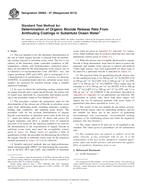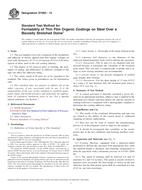Potrebujeme váš súhlas na využitie jednotlivých dát, aby sa vám okrem iného mohli ukazovať informácie týkajúce sa vašich záujmov. Súhlas udelíte kliknutím na tlačidlo „OK“.
ASTM D6903-07(2013)
Standard Test Method for Determination of Organic Biocide Release Rate From Antifouling Coatings in Substitute Ocean Water
Automaticky preložený názov:
Štandardná skúšobná metóda pre stanovenie organických biocídoch Release sadzbu z proti zanášaniu povlaky Náhradník vody oceánu
NORMA vydaná dňa 1.6.2013
Informácie o norme:
Označenie normy: ASTM D6903-07(2013)
Poznámka: NEPLATNÁ
Dátum vydania normy: 1.6.2013
Kód tovaru: NS-36947
Počet strán: 21
Približná hmotnosť: 63 g (0.14 libier)
Krajina: Americká technická norma
Kategória: Technické normy ASTM
Kategórie - podobné normy:
Anotácia textu normy ASTM D6903-07(2013) :
Keywords:
antifouling coating, copper pyrithione (CuPT), N-cyclopropyl-N&prime,-(1,1-dimethylethyl)-6-(methylthio)-1,3,5-triazine-2,4-diamine (CDMTD), organic biocide, release rate, zinc pyrithione (ZPT), 4,5-dichloro-2-n-octylisothiazolin-3-one (DCOIT), ICS Number Code 25.220.60 (Organic coatings)
Doplňujúce informácie
| Significance and Use | ||||||||||
|
4.1 This test method is designed to provide a laboratory procedure to quantify and characterize changes in the release rate of organic biocide from antifouling coatings that occur during a period of immersion under specified laboratory conditions of constant temperature, pH, salinity, and hydrodynamics. Quantitative measurement of biocide release rate is necessary to help in selection of materials, providing quality control, and understanding the performance mechanism. 4.2 Results from this test method establish a pattern of biocide release from an antifouling coating over a minimum of 45 days exposure under controlled laboratory conditions. Biocide release rates of antifouling paints in-service vary over the life of the coating system depending on the formulation and on the physical and chemical properties of the environment. Factors such as differences in berthing locations, operating schedules, length of service, condition of paint film surface, temperature, pH, and salinity influence the actual release rate under environmental conditions. Results obtained using this test method do not reflect actual biocide release rates that will occur in service, but provide comparisons of the release rate characteristics of different antifouling formulations in substitute ocean water under the prescribed laboratory conditions. 4.3 By comparison with published copper and organotin release rate data4,5 obtained either by direct measurements from ship hulls or release rate measurements from harbor exposed panels, all data indicate that the results of this generic rotating-cylinder test method significantly overestimate the release rate of biocide when compared to release rates under in-service conditions. For example, published results demonstrate that this generic test method produces higher measurements of copper and organotin release rates than from direct in situ measurements for the same coating on in-service ship hulls and harbor-exposed panels. The difference between the results of this test method and the panel and ship studies was up to a factor of about 30 based on copper release rate data for several commercial antifouling coatings.4, 6 No direct release rate data from ship hulls or harbor-exposed panels have been generated to-date for the biocides covered by this method. However, the expectation is that the results of this test method, when compared with the direct measurements from ship hulls and harbor-exposed panels, could follow the same trend. Realistic estimates of the biocide release from a ship’s hull under in-service conditions can only be obtained from this test method where the difference between the results obtained by this test method and the release rate of an antifouling coating in service is taken into account. 4.4 Where the results of this test method are used in the process of generating environmental risk assessments, for environmental loading estimates, or for regulatory purposes, it is most strongly recommended that the relationship between laboratory release rates and actual environment inputs is taken into account to allow a more accurate approximation of the biocide release rate from antifouling coatings under real-life conditions. This can be accomplished through the application of appropriate correction factors.6 |
||||||||||
| 1. Scope | ||||||||||
|
1.1 This test method covers the laboratory determination of the rate at which organic biocide is released from an antifouling coating exposed in substitute ocean water. The test is run entirely in the laboratory under controlled conditions of pH, temperature, salinity, and hydrodynamics. Analytical procedures are provided for the determination of the release rate of 4,5-dichloro-2-n-octylisothiazolin-3-one (DCOIT), zinc and copper pyrithione (ZPT and CuPT), and N-cyclopropyl-1.2 In cases in which the antifouling coating contains both an organic biocide and a copper-based biocide, the release rate of copper may optionally be concurrently determined according to the procedure found in Test Method D6442. 1.3 The procedure contains the preparation steps for the determination of the release rate of biocide in substitute ocean water from antifouling paints including apparatus, reagents, holding tank conditions, and sampling point details. The procedure calls for the accurate determination of organic biocide concentrations in substitute ocean water at the low 1.4 Suitable analytical methods that use high-performance liquid chromatography (HPLC) for determining the concentration of DCOIT, ZPT and CuPT, and CDMTD in substitute ocean water are given in 1.5 When the release rate of a highly photosensitive organic biocide is being determined, steps must be taken to protect the apparatus and samples from exposure to natural and artificial visible light sources. Any such requirement for these steps to be taken for a particular biocide is indicated in 1.6 The practical limits for quantifying biocide release rates by this method are from 4.5 to 500 1.7 The results of this test method do not reflect environmental biocide release rates for antifouling products, and are not suitable for direct use in the process of generating environmental risk assessments, environmental loading estimates, or for establishing release rate limits for regulatory purposes. See also Section 4. 1.8 The values stated in SI units are to be regarded as the standard. The values given in parentheses are for information only. 1.9 This standard does not purport to address all of the safety concerns, if any, associated with its use. It is the responsibility of the user of this standard to establish appropriate safety and health practices and determine the applicability of regulatory limitations prior to use. |
||||||||||
| 2. Referenced Documents | ||||||||||
|
Podobné normy:
Historická
1.12.2010
Historická
15.10.2013
Historická
1.6.2013
Historická
1.7.2013
Historická
1.11.2013
Historická
1.12.2010
Odporúčame:
Aktualizácia technických noriem
Chcete mať istotu, že používate len platné technické normy?
Ponúkame Vám riešenie, ktoré Vám zaistí mesačný prehľad o aktuálnosti noriem, ktoré používate.
Chcete vedieť viac informácií ? Pozrite sa na túto stránku.



 ASTM D6991-05(2010)..
ASTM D6991-05(2010).. ASTM D7027-13
ASTM D7027-13 ASTM D7093-13
ASTM D7093-13 ASTM D7835/D7835M-13..
ASTM D7835/D7835M-13.. ASTM D7893-13
ASTM D7893-13 ASTM D968-05(2010)..
ASTM D968-05(2010)..
 Cookies
Cookies
